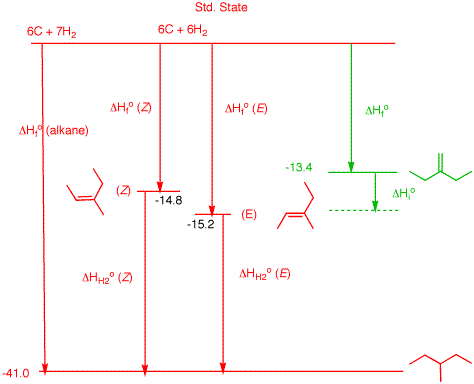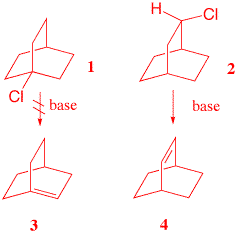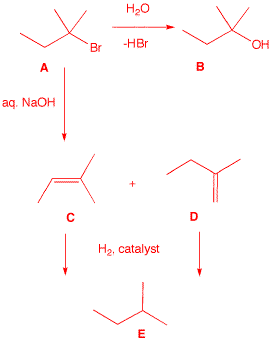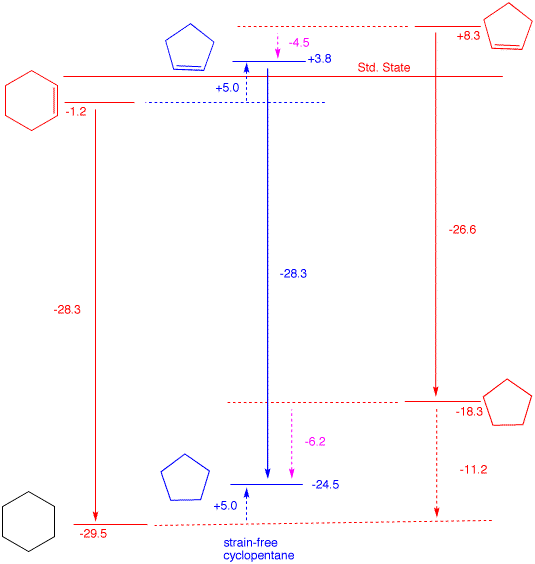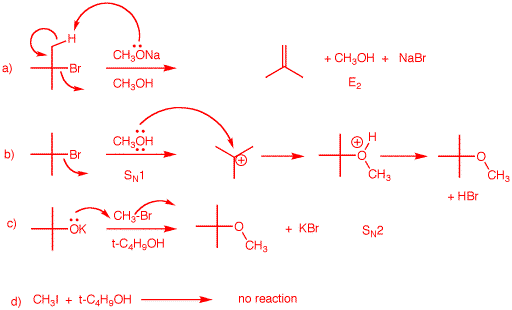|
1. Read Degree
(Elements) of Unsaturation. How
many degrees of unsaturation are present in
C10H12BrClN2OS? Draw two
structures, one cyclic, the other acyclic, that have the
number of degrees of unsaturation you determined and that is
necessarily in agreement with the formula.
2. a) Estimate the heat of
hydrogenation of 3-ethyl-2-pentene using the
heat
of formation table. Show
work. (E)-3-methyl-2-pentene:
ΔHfo = -15.2 kcal/mol d) There is only one disubstituted alkene
isomer of the (E)-and (Z)- isomers in 2b. What is its
structure? Assuming that ΔGo = ΔHo,
which of the three isomeric alkenes would dominate in an
equilibrium mixture? How much heat is liberated in the
isomerization of the disubstituted alkene to the
(E)-isomer? Show work. Add the disubstituted alkene
to your diagram in 2c and illustrate the heat of
isomerization. |
Paul Sabatier 1912 Co-Nobel Prize in Chemistry Hydrogenation by Metal Catalysis
3. a) [2.2.2]-Bicyclooctane forms
how many monochloro constitutional isomers upon free radical
chlorination? What are their structures?
Structures are
1 and 2 (above).
There are only two bridgehead, tertiary hydrogens and 12
secondary hydrogens. Chloroalkane 1 is
achiral; secondary chloride 2 will be a
racemate. If H and Cl are switched, the enantiomer of
2 would
arise. |
|
4. Compound A
(C5H11Br) reacts readily with water to
form B, C5H12O. Exposure of
compound A to aq. NaOH gives only C (major)
and D (minor). Hydrogenation of C liberates
26.8 ± 0.1 kcal/mol heat while D liberates 28.4
± 0.1 kcal/mol of heat during hydrogenation. Both
C and D form E upon hydrogenation. What
are the structures A-E? Explain.
Compounds
A and B have 0
degrees of unsaturation. They are both acyclic and devoid of
unsaturation. Compound reacts readily with water
(SN1) to form B, an alcohol,
requires compound A to be tertiary
bromide. With only five carbons available, there is only one
possible structure for A:
2-bromo-2-methylbutane. Compound B is
then 2-methyl-2-butanol. Compounds C
and D are the products of E2
elimination. Since hydroxide is a small base, the major
produc C must be the trisubstituted
alkene 2-methyl-2-butene and D is the
alkene 2-methyl-1-butene. For the heats of hydrogenation:
(text, Table 7-1), C: -26.9 kcal/mol;
D: -28.5 kcal/mol.
(ΔHfo
table [calc'd.]) C: -26.7
kcal/mol ; D: -28.3 kcal/mol. The
values are consistent.
|
|
5. a) Determine the heat of hydrogenation
of cyclohexene from the heat
of formation tables. b) How does
this value compare with the heat of hydrogenation of an
unstrained cis-disubstituted double bond? c) Given the heat
of hydrogenation of cyclopentene (chapter 7) determine the
heat of formation of cyclopentene. d) BONUS: Why is the heat
of hydrogenation less for cyclopentene than that for
cyclohexene? Show all work. BONUS: The
diagram on the right contains the data (in red) for
5a and 5b. Since cyclohexane and cyclohexene are
unstrained, the difference for the heat of
hydrogenation of cyclopentene vs. cyclohexene must
lie with either strain in cyclopentane and/or
cyclopentene. One approach is to have a vitual,
strain-free cyclopentane (ΔHfo
= -24.5 kcal/mol) and cyclopentene
(ΔHfo
= +3.8 kcal/mol)
(in
blue).
The heats of formation of these two can be
determined by adding +5 kcal/mol to the heats of
formation of cyclohexane and cyclohexene. Recall
that the difference in the heat of formation of
n-pentane and n-hexane is ~5 kcal/mol. Note that
the heat of hydrogenation of this strain-free
cyclopentene is the same as the heat of
hydrogenation of cyclohexene. Thus, virtual
cyclopentene lies 4.5 kcal/mol below real
cyclopentene and virtual cyclopentane lies 6.2
kcal/mol below real cyclopentane
(magenta
in
diagram).
This analysis suggests that there is relatively
more strain in cyclopentane than in cyclopentene.
The difference between 6.2 and 4.5 kcal/mol is the
same as the difference in the heats of
hydrogenation. |
|
6. Two stereoisomers, A and
B, absorb one equivalent of hydrogen upon catalytic
hydrogenation to form cyclooctane. Compound A, which
is capable of resolution, liberates 34.5 kcal/mol of heat
while B liberates 24.3 kcal/mol of heat. ΔHfo
(cis-cyclooctene) = ΔHfo
(cyclooctane) - ΔHH2o; -29.7
- (24.3) = -5.4 kcal/mol for ΔHfo
(cis-cyclooctene). |
|
7. Comment critically on the following
proposed synthesis of the now banned gasoline additive,
methyl tertiary-butyl ether (MTBE). If you believe the
reaction will be successful, provide the type of mechanism
that is operable and illustrate it with the curved arrow
formalism. If you feel that the reaction will not be
successful, state the expected product of the reaction and
the mechanism by which it is formed. Illustrate with curved
arrows. If no reaction takes place, state so and explain why
not. a) Tertiary
halides in the presence of strong base undergo
E2 elimination, not substitution. |

